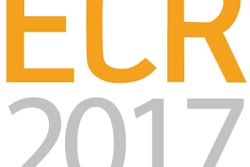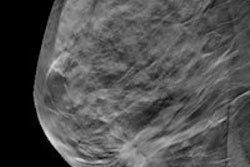
Digital breast tomosynthesis (DBT) is not all it's cracked up to be in results that researchers from Cambridge, U.K., have called "surprising." The technique's preferred when assessing lesion visibility and extent and also when discriminating between malignant and benign lesions, but synthetic 2D is proving superior when viewing microcalcifications.
 Dr. Fiona Gilbert from the University of Cambridge.
Dr. Fiona Gilbert from the University of Cambridge.The retrospective reading study -- using data from the TOMMY trial -- compared the sensitivity and specificity of full-field digital mammography (FFDM), FFDM with DBT, and synthetic 2D (reconstructed DBT images) with DBT.
The research team, led by Dr. Fiona Gilbert from the University of Cambridge, found DBT was preferred for almost everything, except for microcalcifications.
"The area where the synthetic results with DBT were not as good was with microcalcifcations," she said during a presentation at ECR 2016. "I was slightly surprised when the readers preferred the synthetic image," and then relied on DBT for discrimination, she added.
Results
In the quest to improve upon mammography, DBT has come front and center, but much research is still being conducted to determine how best to use the modality and if it can replace mammography for good.
As part of this research, Gilbert and her colleagues evaluated reader preferences and sought to determine which image format best demonstrates different radiological features. They compared FFDM with DBT and synthetic 2D with DBT. Images were then scored for lesion visibility, lesion extent, discrimination, and overall opinion on a five-point scale. The readers were also asked to state whether DBT was better or worse than 2D or synthetic 2D.
The researchers categorized more than 7,000 cases by dominant radiological feature: microcalcification, circumscribed mass, spiculated mass, asymmetric density, distortion, or none.
Gilbert's team found that DBT images were preferred in all categories of radiological features (p < 0.01 for all) compared with both FFDM and synthetic 2D images except for microcalcification, where synthetic 2D was preferred instead.
Readers' scores for overall opinion also showed a significant preference for DBT (p < 0.01) for all radiological features except microcalcification, where, again, synthetic 2D was preferred.
There was an enhancement on synthetic 2D with microcalcifications that helped the readers, which is probably why they preferred synthetic 2D, Gilbert noted.
"Readers definitely got more info from DBT when comparing it with 2D and/or just the synthetic images for masses, asymmetric densities, and distortions," she said. "But the interesting thing is the readers got the impression that the microcalcifications were much better [visualized] on synthetic images when they compared them to the slice images on DBT."
However, when trying to discriminate, the readers used the DBT slices to decipher whether what they saw was in fact benign or malignant.
"We think it's because there is a bit of loss of intrinsic detail that we get from the slices when you're trying to decipher whether something is benign or malignant," she said.



















